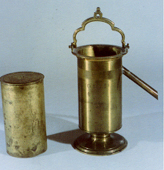
15 x 11.5 x 6.3
Copper
INDEX 1788 : O.I.241
Cylindrus cavus cupreus, ansa instructus, ut capillo equino suspendi possit. Hujus cavitatem exacte replet cylindrus alter accurate elaboratus, in cujus basis superioris centro uncus haeret exiguus, et in centro basis inferioris foramen cernitur, per quod globuli plumbei minores cylindro inseruntur, quo pondus ad libitum mutari potest; cochlea autem foramen clauditur. Ambo cylindri adhibentur cum Bilance praedicta
ad ostendendum corpus fluido immersum tantum sui ponderis amittere, quantum
habet fluidum ejusdem voluminis cum Corpore.
A hollow copper cylinder equipped with a handle in order to be hung from a hairspring. The interior of this cylinder is exactly filled by another one, carefully made, at the centre of whose upper base a little hook is fixed,
and at the centre of whose lower base a hole can be seen by which little
balls of lead smaller than the cylinder are introduced, so that the weight
can be altered at will. The hole is closed with a screw. Both the cylinders
are presented with a balance to show that a body immersed in a fluid
loses as much of its weight as that of the fluid of the same volume as
the body.
This is a classical apparatus, still current today, to demonstrate Archimedes' Principle. It consists of a cylinder and a cylindrical vessel, made so that the first fits exactly inside the second. The cylindrical vessel is suspended from the underside of one of the pans of a balance, and from its base the cylinder is suspended. The pair of cylinders is balanced by placing a counterweight on the other pan of the balance. If, with this arrangement, the cylinder is immersed in a liquid, the apparatus becomes unbalanced. However, when the cylindrical vessel is filled with the same liquid, the balance returns to equilibrium proving Archimedes' Principle which states that the impulsion force is equal to the weight of volume of liquid displaced by the body.
The equipment in the Gabinete de Física in Coimbra consists of a cylindrical copper vessel, with a circular base similar to that of a glass, and a handle so that it can be suspended. There is also a lateral tube that serves to limit the volume of liquid that it can contain. The cylinder, also made of copper, is exactly the same height as the height of the liquid that the vessel is able to contain without it pouring out through the lateral tube. In the base there is a little hole that enables little grains of lead to be introduced into the empty interior to vary the weight of the cylinder. A screw is used to plug the hole.
From Colégio dos Nobres, catalogue n.º 231.
Carvalho, Rómulo de, História do Gabinete de Física da Universidade de Coimbra, Universidade de Coimbra, Biblioteca Geral, Coimbra, 1978, pp. 406-408.
's Gravesande, Williem Jacob, Physices Elementa, Leiden, 1742, Tab. XLIX, Figs. 1 and 2.